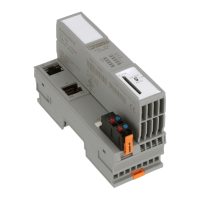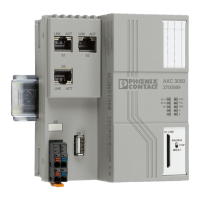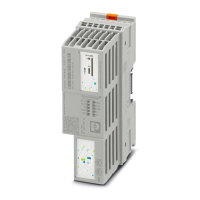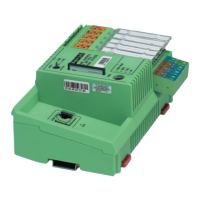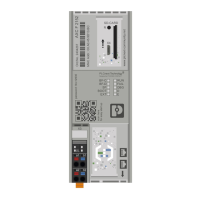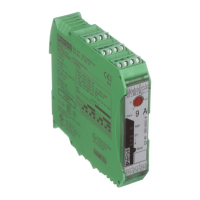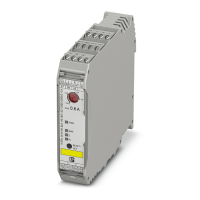Do you have a question about the Phoenix Contact RFC 4072S and is the answer not in the manual?
Covers warning identification, user qualifications, manual purpose, licensing, and source code request.
Details general safety notes, electrical safety measures, and safety of the machine or system.
Lists standards, intended use, documentation, system requirements, and disposal information.
Provides a list of abbreviations and contact information for safety support.
Describes the RFC's general features, safety modes, and response time calculation.
Details physical indicators, interfaces, operating elements, and the diagnostic display structure.
Covers safety during installation, mounting the RFC and fan module, and handling SD/USB cards.
Explains connecting interfaces, power supply, and the procedure for replacing the RFC.
Outlines initial startup, restart procedures, startup examples, and necessary software.
Details IP configuration, controller connection, PROFINET device setup, and I/O modules.
Covers programming basics, data assignment, project transfer, and viewing online values.
Guides on HMI creation, safety programming, project transfer, and debug mode operations.
Details diagnostic mechanisms for PROFINET, F-Devices, and the iSPNS 3000 controller.
Lists possible errors with codes, their causes, and how to evaluate diagnostic messages.
Covers device maintenance, replacing components like the fan module, and updating firmware.
Outlines procedures for device repair, decommissioning, and environmentally sound disposal.
Explains resetting the controller and changing IP settings using the device display.
Covers accessing parameterization memory, setting the realtime clock, and downloading changes.
Details PROFINET device startup, substitute value behavior, and Ethernet communication function blocks.
Describes PROFINET AR management, web server functionality, and OPC UA support.
Provides general information on system variables and details PROFIsafe/PROFINET specific variables.
Lists system variables for iSPNS 3000, including status and parameter registers.
Covers system variables for task handling, HMI, sockets, device state, and time.
Outlines WBM requirements, connection setup, and navigating the web interface.
Details security settings including user authentication, certificate management, and firewall configuration.
Provides step-by-step instructions for updating the device firmware using the WBM interface.
Details general device dimensions, weight, mounting, and power supply requirements.
Covers runtime systems, parameterization, fan module, and ambient condition specifications.
Lists mechanical, safety, EMC characteristics, and product approvals.
Provides a catalog of orderable controllers, modules, accessories, and software.
Provides references to documentation for software and security application notes.
Covers firmware control commands, HTTPS certificate replacement, and interface specifications.
Defines PROFIsafe terms and provides checklists for planning, programming, and validation.
Compiles lists of all figures and tables included in the manual.
Details the revision history and changes made to the user manual.
Covers warning identification, user qualifications, manual purpose, licensing, and source code request.
Details general safety notes, electrical safety measures, and safety of the machine or system.
Lists standards, intended use, documentation, system requirements, and disposal information.
Provides a list of abbreviations and contact information for safety support.
Describes the RFC's general features, safety modes, and response time calculation.
Details physical indicators, interfaces, operating elements, and the diagnostic display structure.
Covers safety during installation, mounting the RFC and fan module, and handling SD/USB cards.
Explains connecting interfaces, power supply, and the procedure for replacing the RFC.
Outlines initial startup, restart procedures, startup examples, and necessary software.
Details IP configuration, controller connection, PROFINET device setup, and I/O modules.
Covers programming basics, data assignment, project transfer, and viewing online values.
Guides on HMI creation, safety programming, project transfer, and debug mode operations.
Details diagnostic mechanisms for PROFINET, F-Devices, and the iSPNS 3000 controller.
Lists possible errors with codes, their causes, and how to evaluate diagnostic messages.
Covers device maintenance, replacing components like the fan module, and updating firmware.
Outlines procedures for device repair, decommissioning, and environmentally sound disposal.
Explains resetting the controller and changing IP settings using the device display.
Covers accessing parameterization memory, setting the realtime clock, and downloading changes.
Details PROFINET device startup, substitute value behavior, and Ethernet communication function blocks.
Describes PROFINET AR management, web server functionality, and OPC UA support.
Provides general information on system variables and details PROFIsafe/PROFINET specific variables.
Lists system variables for iSPNS 3000, including status and parameter registers.
Covers system variables for task handling, HMI, sockets, device state, and time.
Outlines WBM requirements, connection setup, and navigating the web interface.
Details security settings including user authentication, certificate management, and firewall configuration.
Provides step-by-step instructions for updating the device firmware using the WBM interface.
Details general device dimensions, weight, mounting, and power supply requirements.
Covers runtime systems, parameterization, fan module, and ambient condition specifications.
Lists mechanical, safety, EMC characteristics, and product approvals.
Provides a catalog of orderable controllers, modules, accessories, and software.
Provides references to documentation for software and security application notes.
Covers firmware control commands, HTTPS certificate replacement, and interface specifications.
Defines PROFIsafe terms and provides checklists for planning, programming, and validation.
Compiles lists of all figures and tables included in the manual.
Details the revision history and changes made to the user manual.
| CPU | ARM Cortex-A8 |
|---|---|
| Operating System | Linux |
| Number of Digital Inputs | 8 |
| Number of Digital Outputs | 8 |
| Number of Analog Inputs | 4 |
| Number of Analog Outputs | 2 |
| Input Voltage | 24 V DC |
| Protection Class | IP20 |
| Installation | DIN rail mounting |
| Programming Languages | C, C++ |
| Communication Protocols | Ethernet, Modbus TCP, PROFINET |
| Interfaces | Ethernet, USB |
| Power Supply | 24 V DC |
| Operating Temperature Range | -20 to +60 °C |
| Ethernet | 2 x RJ45, 10/100/1000 Mbps |
